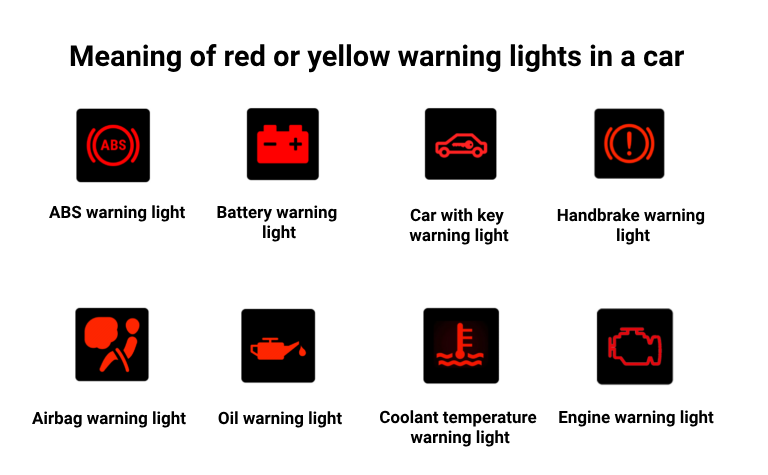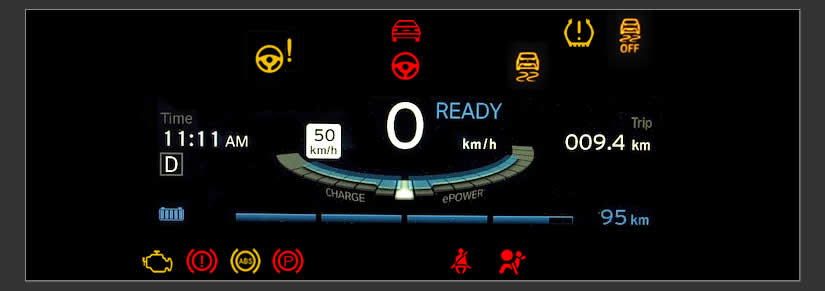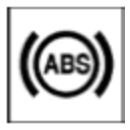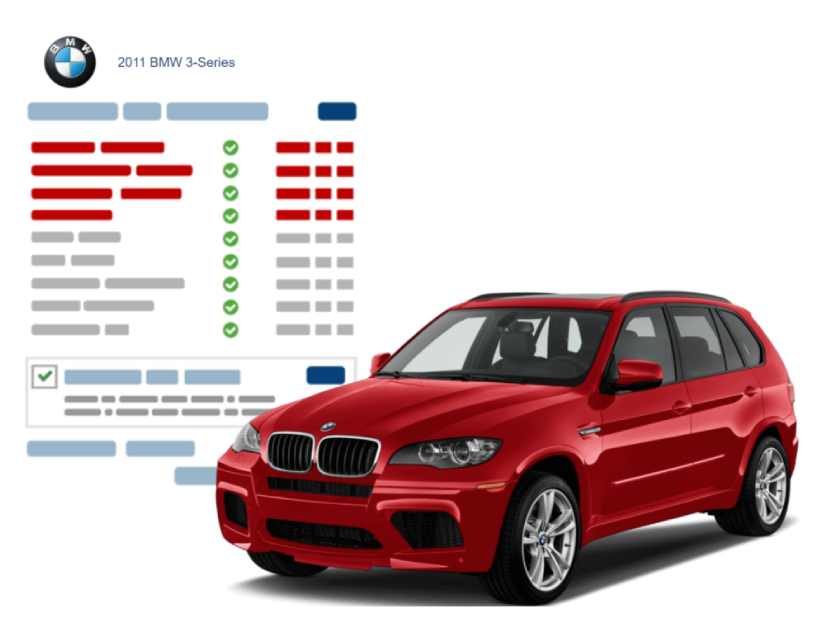
Do you know what the different lights in your car mean? What is this signaling for and what does it actually mean? If you don’t know what the warning lights in your car mean, it’s better to read this entry before you incur serious expenses and cause a serious fault.
To put it simply, the warning lights in a car can be divided into two types: those with which you can continue driving and those with which continuing to drive may result in a serious failure.
In addition, in the owner’s manual of each car you will find symbols of indicators on the dashboard and their description. They may differ slightly, so it is worth checking the warning lights in the car specific to our model.
If you don’t have the manual in book form, try to find it online.

Red lights in the car
The colors of the lights on the dashboard indicate faults. For example, red lights in a car serve as an alarm. If the red “check engine” light comes on in your car while driving, you should stop the vehicle and consult a workshop. As a car user, you may have some suspicions about the fault, or together with the mechanic, based on the symptoms you have recently observed, you may determine what may be the cause of the red light on the dashboard.
Then you will know whether further driving is allowed or not. It is also worth checking whether the red light does not indicate any warning – e.g. a door ajar, an unfastened seat belt (e.g. for a child) or an open trunk lid. Or maybe you just accidentally turned off the ABS…?
However, never ignore the red lights appearing in the car, especially when there is a failure of the braking system or safety systems – e.g. ABS.

Car warning lights indicating problems (yellow or red)
ABS/ESP/other systems indicator light
– its appearance on the dashboard indicates a failure of this system.
Battery light
– indicates problems with battery voltage, either a failure has occurred or the battery is discharged.
Car light with key
– signals a failure of the electronics system.
“Exclamation mark” or “P” light
– this is a handbrake light. It is always on when it is engaged or indicates a failure.
Airbag light
– lights up when, for example, it is turned off or there is a failure.
Oil light
– when it lights up red, it signals problems with the oil in the engine. It may mean a low oil level, or in newer cars better equipped with various sensors, it may indicate poor oil quality and the need to replace it.
Coolant temperature indicator light
– the engine may have overheated.
Check engine light
– a red engine symbol, a light indicating a rather serious failure.
In addition, you may encounter warning lights that indicate, for example, low tire pressure, a burned-out bulb, the need to replace brake pads, etc. Not all of them necessarily mean a failure. They can simply signal a specific vehicle condition and the need for driver intervention. The best example is the fuel reserve light. Warns you of low fuel level. If you don’t refuel, you won’t be able to drive soon.
Indicators in an electric car
You will see similar lights on an electrician’s dashboard. They do not differ much from the typical and familiar warning lights from combustion cars. They are simply enriched with new security systems, such as an alert that appears when a pedestrian is detected in close proximity to the car. However, you can also find such a light in a modern combustion car.
What you definitely won’t see on the dashboard of a combustion car is the battery charge status.

BMW i3 dashboard
In the electric BMW i3, you will find a battery charge indicator on the dashboard, along with the remaining driving range.
Indicator lights in a combustion car – other markings
| Symbol | Indicator description and recommendations |
ABS | The ABS system prevents the wheels from locking during braking. If the BMW i3 ABS warning light is on or comes on while driving, it means that the ABS system is damaged and is not working. When the ABS is damaged, the normal brake will remain functional. However, there is a greater risk of wheel locking during sudden braking. |
Airbag | The airbag light comes on and off when everything is working properly. Remember that it also symbolizes seat belt tensioners. When a failure occurs, the airbag warning light does not come on at all or remains on continuously. In both cases, the airbag system and belt tensioner are damaged and may not deploy in an accident. |
Parking brake | This light means the parking brake is engaged. If it illuminates when the parking brake is not used, there is a fault with this component. |
Active cruise control | The BMW i3 Active Cruise Control icon displays the number of bars as the selected distance from the vehicle in front. It is measured using a camera directed at the road and located in the rear-view mirror. The icon will appear when detecting vehicles, while driving and will signal, for example, an increase in distance. |
Brake | The warning light with an exclamation mark on the BMW i3 is a warning light for the braking system. Indicates that a fault has occurred. You can continue driving at a moderate speed. However, an immediate inspection of the vehicle is required. |
Collision warning system | The car warning light in the BMW i3 indicates the active frontal collision system. If there is an imminent risk of collision, the warning light flashes together with an audible signal. When an error occurs in this system, check whether the camera in the rear-view mirror has not overheated or whether weather conditions are not interfering with the system’s operation. |
Pedestrian warning system | Pedestrian warning system. It works thanks to a camera mounted in the rearview mirror. The indicator light will illuminate when a pedestrian is detected on the road and may trigger automatic braking. The system works during the day and warns about a possible collision with pedestrians at speeds from approximately 10 km/h to 60 km/h. System failure may be caused by overheating of the camera or bad weather conditions. |
DSC | The DSC warning light on the BMW i3 indicates the Dynamic Stability Control system. Appears during system startup when: ▷ Loss of wheel traction when starting or accelerating. ▷ Loss of control when cornering. The DSC light then flashes. When it is on steadily, it means that the system is not working properly and the system should be checked. The DSC system can also be turned off. |
Steering system | The BMW i3 steering warning light comes on when a fault is detected. This may be due to a fault with the power steering module. Turning the steering wheel may be more difficult, especially at slower speeds. A visit to the workshop will be necessary. |
Tire pressure | BMW i3 tire pressure warning light. When it comes on, it indicates a significant loss of pressure in one or more tires. To maintain reliable pressure warnings, it is important that the tire pressure system is reset after each tire or tire pressure change. |
Check Engine | The BMW i3 Check Engine Warning Light only applies to the Range Extender i3. That is, equipped with a two-cylinder petrol engine with a capacity of 0.6 l, which is supposed to charge the car’s batteries in emergency situations. It lights up for the following reasons: ▷ Lights up: exhaust emissions have deteriorated. This can result in poor engine performance and fuel economy. ▷ Flashing: indicates that the engine is misfiring and that unburnt fuel is entering the exhaust system, which may damage the catalytic converter. Reduce your speed immediately and have your vehicle checked. Diagnostic equipment is required to find the cause of the fault. You should take your vehicle to a workshop that specializes in BMW i3. |


















